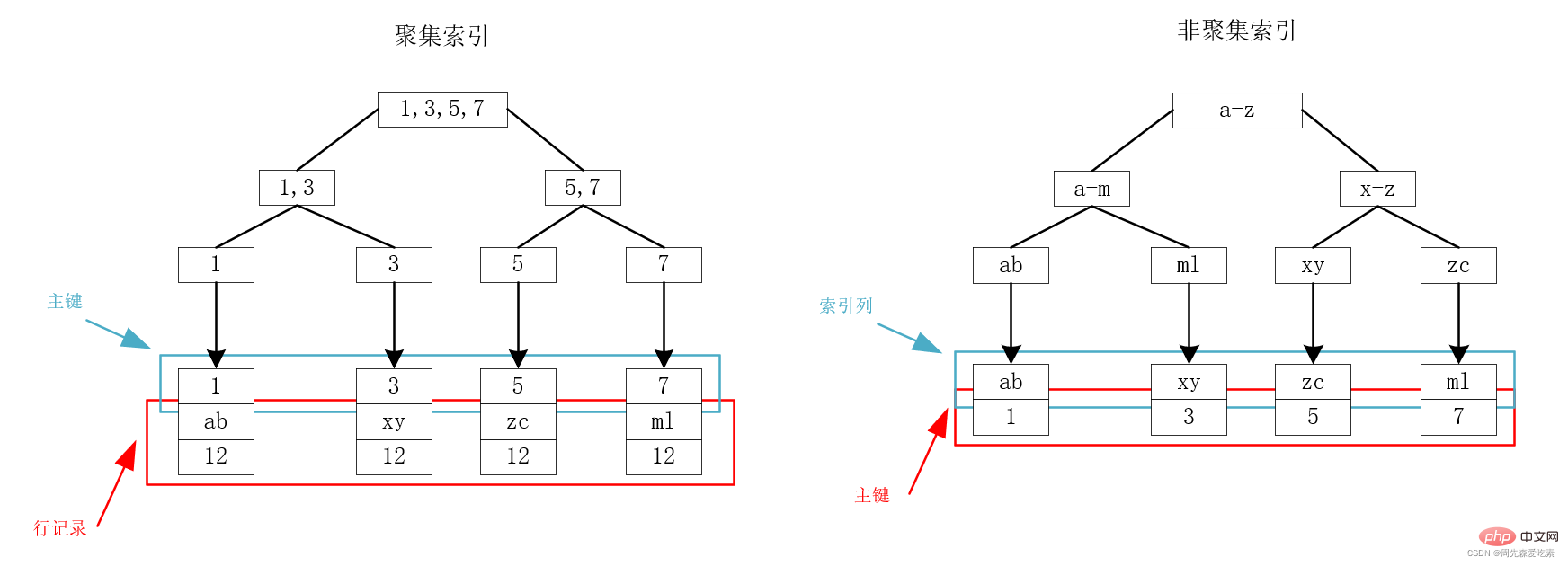
Recommended learning:mysql video tutorial
For subsequent instructions, we first create a The following table (MySQL5.7) has 5 fields in total (a,b,c,d,e), whereais the primary key, there is a joint index composed ofb,c,d, the storage engine is InnoDB, and three pieces of test data are inserted.It is strongly recommended that you try all the statements in this article in MySQL.
CREATE TABLE `test` ( `a` int NOT NULL AUTO_INCREMENT, `b` int DEFAULT NULL, `c` int DEFAULT NULL, `d` int DEFAULT NULL, `e` int DEFAULT NULL, PRIMARY KEY(`a`), KEY `idx_abc` (`b`,`c`,`d`) ) ENGINE=InnoDB DEFAULT CHARSET=utf8mb4 COLLATE=utf8mb4_0900_ai_ci; INSERT INTO test(`a`, `b`, `c`, `d`, `e`) VALUES (1, 2, 3, 4, 5); INSERT INTO test(`a`, `b`, `c`, `d`, `e`) VALUES (2, 2, 3, 4, 5); INSERT INTO test(`a`, `b`, `c`, `d`, `e`) VALUES (3, 2, 3, 4, 5);
At this time, if we execute the following SQL statement, do you think the index will be used?
SELECT b, c, d FROM test WHERE d = 2;
If you follow the leftmost matching principle (simply stated as in the joint index, start matching from the leftmost field, if the fields in the condition match the order from left to right in the joint index, then go to the index, Otherwise, it can be simply understood that the joint index of (a, b, c) is equivalent to creating a index, (a, b) index and (a, b, c) index). This sentence obviously does not comply with this rule. Yes, it cannot go through the index, but if we use theEXPLAINstatement to analyze it, we will find a very interesting phenomenon. Its output is as follows using the index.

This is very strange. Has the leftmost matching principle failed? In fact, no, let’s analyze it step by step.
Since the InnoDB engine is basically the main engine now, we use InnoDB as an example for the main explanation.
The bottom layer of MySQL uses B-tree to store the index, and the data is stored on the leaf nodes. For InnoDB, the primary key index and row records are stored together, so it is called a clustered index. Except for the clustered index, all others are called non-clustered indexes (secondary index), including ordinary indexes, unique indexes, etc.
In InnoDB, there is only one clustered index:
Let’s take the following figure as an example. Suppose there is a table with three fields: id, name, and age. ID is the primary key, so id is a clustered index, and name is indexed as a non-clustered index. Regarding the index of id and name, there is the following B-tree. You can see that the leaf nodes of the clustered index store the primary key and row records, and the leaf nodes of the non-clustered index store the primary key.

From the above index storage structure, we can see that on the primary key index tree, one-time query can be done through the primary key Find out the data we need very quickly. This is very intuitive, because the primary key is stored together with the row record. Once the primary key is located, the record containing all the fields that you are looking for is located.
But for non-clustered indexes, as shown in the right picture above, we can see that we need to first find the corresponding primary key according to the index tree where name is located, and then query the desired record through the primary key index tree. This process is called return Table query.
The above table return query will undoubtedly reduce the efficiency of the query, so is there any way to prevent it from returning the table? This is index coverage. The so-called index coverage means that when using this index to query, the data on the leaf nodes of its index tree can cover all the fields you query, so that you can avoid returning the table. Let's go back to the initial example. We established the joint index of(b,c,d), so when the fields we query are in b, c, d, the table will not be returned. The index tree only needs to be viewed once, which is index coverage.
refers to the index of the leftmost column in the joint index. The same applies to joint indexes on multiple fields. For example, index(a,b,c) joint index is equivalent to creating a single column index, (a,b) joint index, and (a,b,c) joint index.
We can execute the following statements to verify this principle.
EXPLAIN SELECT * FROM test WHERE b = 1;

EXPLAIN SELECT * FROM test WHERE b = 1 and c = 2;

EXPLAIN SELECT * FROM test WHERE b = 1 and c = 2 and d = 3;

接着,我们尝试一条不符合最左原则的查询,它也如图预期一样,走了全表扫描。
EXPLAIN SELECT * FROM test WHERE d = 3;

我们先来看下面两个语句,他们的输出如下。
EXPLAIN SELECT b, c from test WHERE b = 1 and c = 1; EXPLAIN SELECT b, d from test WHERE d = 1;
id|select_type|table|partitions|type|possible_keys|key |key_len|ref |rows|filtered|Extra | --+-----------+-----+----------+----+-------------+-------+-------+-----------+----+--------+-----------+ 1|SIMPLE |test | |ref |idx_bcd |idx_bcd|10 |const,const| 1| 100.0|Using index| i d|select_type|table|partitions|type |possible_keys|key |key_len|ref|rows|filtered|Extra | --+-----------+-----+----------+-----+-------------+-------+-------+---+----+--------+------------------------+ 1|SIMPLE |test | |index|idx_bcd |idx_bcd|15 | | 3| 33.33|Using where; Using index|
显然第一条语句是符合最左匹配的,因此type为ref,但是第二条并不符合最左匹配,但是也不是全表扫描,这是因为此时这表示扫描整个索引树。
具体来看,index代表的是会对整个索引树进行扫描,如例子中的,列d,就会导致扫描整个索引树。ref代表 mysql 会根据特定的算法查找索引,这样的效率比 index 全扫描要高一些。但是,它对索引结构有一定的要求,索引字段必须是有序的。而联合索引就符合这样的要求,联合索引内部就是有序的,你可以理解为order by b,c,d这种排序规则,先根据字段b排序,再根据字段c排序,以此类推。这也解释了,为什么需要遵守最左匹配原则,当最左列有序才能保证右边的索引列有序。
因此,我们总结最后的原则为,若符合最左覆盖原则,则走ref这种索引;若不符合最左匹配原则,但是符合覆盖索引(index),就可以扫描整个索引树,从而找到覆盖索引对应的列,避免回表;若不符合最左匹配原则,也不符合覆盖索引(如本例的select *),则需要扫描整个索引树,并且回表查询行记录,此时,查询优化器认为这样两次查找索引树,还不如全表扫描来得快(因为联合索引此时不符合最左匹配原则,要不普通索引查询慢得多),因此,此时会走全表扫描。
减少开销。建一个联合索引(col1,col2,col3),实际相当于建了(col1),(col1,col2),(col1,col2,col3)三个索引。每多一个索引,都会增加写操作的开销和磁盘空间的开销。对于大量数据的表,使用联合索引会大大的减少开销!
覆盖索引。对联合索引(col1,col2,col3),如果有如下的sql: select col1,col2,col3 from test where col1=1 and col2=2。那么MySQL可以直接通过遍历索引取得数据,而无需回表,这减少了很多的随机io操作。减少io操作,特别的随机io其实是dba主要的优化策略。所以,在真正的实际应用中,覆盖索引是主要的提升性能的优化手段之一。
效率高。索引列越多,通过索引筛选出的数据越少。有1000W条数据的表,有如下sql:select from table where col1=1 and col2=2 and col3=3,假设假设每个条件可以筛选出10%的数据,如果只有单值索引,那么通过该索引能筛选出1000W10%=100w条数据,然后再回表从100w条数据中找到符合col2=2 and col3= 3的数据,然后再排序,再分页;如果是联合索引,通过索引筛选出1000w10% 10% *10%=1w,效率提升可想而知!
推荐学习:mysql视频教程
The above is the detailed content of Detailed example of MySQL index leftmost matching principle. For more information, please follow other related articles on the PHP Chinese website!